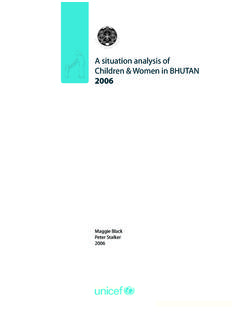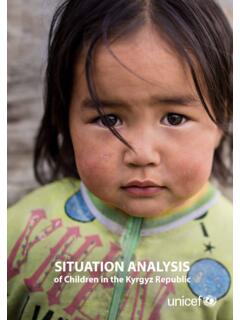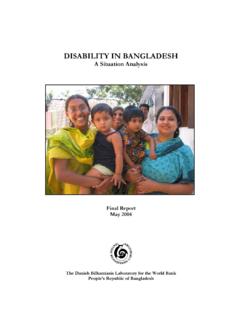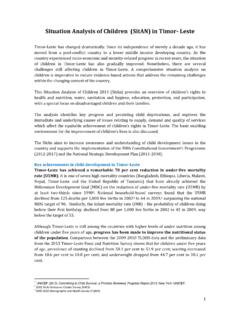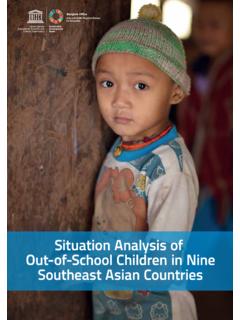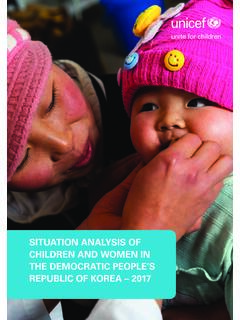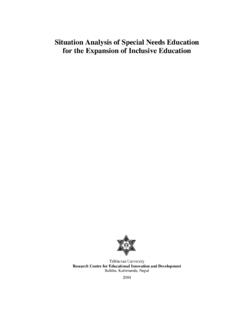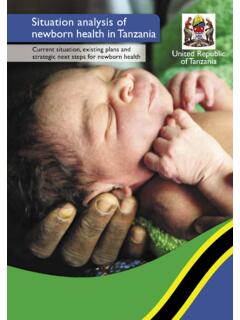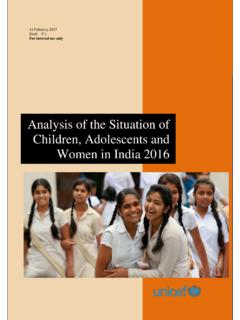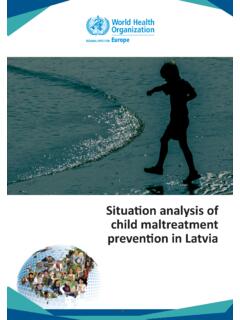Transcription of The Situation of Children and Women in Liberia
1 2012 From Conflict to Peace The Situation of Childrenand Women in LiberiaThe Situation of Children and Women in Liberia 2012 From Conflict to PeaceUNICEF is very grateful to all individuals from the government, civil society, national and international development partners, UN agencies, Women and youth groups for their valuable inputs in making this document a credible information source to support strategies towards improving the lives of Children and Women in Liberia over the next five appreciates the original and initial drafting carried out by Maggie Black and contributions to analysis and drafting by Dennis thanks go to the UNICEF Liberia staff team for their dedicated Design: Ashraf Otrosh and Tyrence W. Moore, JrCover photo: UNICEF/LBR/2011/Pirozzi CONTENTSE xecutive 1 Priority 3 Introduction to the Situation 6 Chapter 1: The Liberian Development Planning Environment.
2 14 Chapter 2: The Early Years Infants and Young Children , aged 0-5 years .. 42 Chapter 3: Early Formative Years Children starting school, aged 6-11 years .. 60 Chapter 4: Later Formative Years and Emergent Years Adolescents, aged 12-17 years .. 76 Chapter 5: Early Adulthood Earning and Contributing Years: Women and Men, aged 18 to about 35 years .. 90 Chapter 6: Adulthood Career Advancing Years Women and Men, aged about 35 to 60 years ..104 Chapter 7: Elders The Dividend Years, aged over 60 years ..110 Chapter 8: Conclusions ..114 Key Lessons, Themes and Gaps ..115 Annex: Equity Figures ..121 The Situation of Children and Women in Liberia 2012 IIALP Accelerated Learning ProgrammeANC Ante Natal CareBCG Bacillus Calmette-Gu rin - vaccine against tuberculosisBPHS Basic Package of Health ServicesBRAC An NGO, with headquarters in Bangladesh and a focus on microfinanceCESCR Committee on Economic, Social and Cultural Child Friendly SpacesCHC Community Health CommitteeCHV Community Health Volunteer (gCHV general CHV)CLTS Community Led Total SanitationCRC Convention on the Rights of the ChildCRID Centre for the Rehabilitation of the Injured and DisabledCWC Child Welfare CommitteeCWIQ Core Welfare Indicators QuestionnaireDNA Deoxyribo Nucleic Acid double helix structure of genesDPT Diphtheria, Pertussis (whooping cough)
3 , Tetanus immunisationECCD Early Childhood Care & DevelopmentECE Early Childhood EducationEGDS Economic Growth and Development Strategy (2013 - 2017)EMIS Education Management Information System FAO Food and Agriculture OrganizationFGM Female Genital Mutilation GBV Gender Based ViolenceGER Gross Enrolment RateHHP Household Health PromoterHMIS Health Management Information System ILO International Labour OrganizationIMR Infant Mortality RateITN Insecticide Treated NetJPAGD Joint Programme for Adolescent Girls DevelopmentLDHS Liberia Demographic and Health SurveyLISGIS Liberia Institute of Statistics and Geo-Information ServicesLMNS Liberia Micronutrient SurveyLPERP Liberian Primary Education Recovery ProgrammeMCH Maternal & Child HealthMDG Millennium Development GoalMMR Maternal Mortality RatioACRONYMSIIINER Net Enrolment RateNFE Non-Formal Education NGO Non-Governmental OrganizationMoHSW Ministry of Health & Social WelfarePMTCT Prevention of Mother to Child
4 Transmission (of HIV)PRS Poverty Reduction StrategyRED Reaching Every District (with immunisation)REPW Reaching Every Pregnant WomanSGBV Sexual and Gender Based ViolenceSTI Sexually-Transmitted InfectionTBA Traditional Birth AttendantTTM Trained Traditional MidwifeTRC Truth & Reconciliation CommissionUCLA University of California, Los AngelesUNDAF United Nations Development Assistance FrameworkUNHCR UN High Commission for RefugeesUNFPA United Nations Fund for PopulationUNMIL United Nations Mission in LiberiaWASH Water, Sanitation & HygieneWFP World Food ProgrammeWHO World Health OrganizationYEE Youth Employment and EmpowermentThe Situation of Children and Women in Liberia 2012IV UNICEF/LBR/2011/AsselinThe Liberian Development Planning Environment VFor too long, Liberia has neglected its Children and discriminated against its Women .
5 They have been unable to fulfil their potential, contribute to Liberia s prosperity and benefit from its development. That picture is beginning to change and this report shows what is being achieved, but also how far we have to go. As I said in my annual message to the National Legislature in January 2012 on the theme Reflecting the Past, Claiming the Future : we must pay special attention to our girls. It will be to Liberia s benefit when our Women are educated and contribute as equal partners in government and the private sector. As I travel around the country, it breaks my heart to see what are, virtually, babies having babies teenage girls raising families when they should be in school. Large numbers of young girls live on the streets, and resort to prostitution to make a living. Many girls, some very young, have their dignity and their future un-dermined by the viciousness of rape.
6 This must be unacceptable truths for all of us . I went on to describe some of the actions my government will take to address the problems that this report also highlights. We will reopen and expand girls boarding schools; support enterprise development and the possibility for every young person to own their own business; continue the past five years six-fold increase in skilled birth attendants and the near doubling of the population who live within five kilometres of a health intend to improve the quality of life for ALL our citizens, empower our youth, create jobs and oppor-tunity and spread development to all our people. We cannot achieve our ambitions alone and we value all our partners. We are developing a clear Agenda for Transformation behind which our partners can align. Our policies will be based on evidence of our real Situation and of what works.
7 I am grateful to UNICEF for commissioning this report, which highlights a number of actions that need to be taken to improve the Situation of Children and Women : implement the Children s Law that I launched at the Liberia Children s Festival on 4th February; ensure Birth Registration for all Children ; ensure that Children do not start life malnourished, damaging them for life; find innovative ways of providing education for those living in re-mote areas; develop positive transitions from childhood to adolescence; support government s planned Child Wellbeing Index; develop social protection for the most vulnerable households that will prevent transmitting poverty from one generation to report highlights the need to build an inclusive society in which youth are partners in peace-building and reconciliation. Our youth are the future of our country, and their future is in our hands.
8 If we invest well and educate them, our future will be bright; if we invest poorly, fail to nurture and develop our young talent, then our future will look dim. I urge you to read this report and to determine what you can do to make a Excellency Mrs. Ellen Johnson SirleafPresident of the Republic of LiberiaPresident Ellen Johnson Sirleaf launches the Children s Law at the Liberia Children s Festival February 2012 The Situation of Children and Women in Liberia 2012VI UNICEF/LBR/2011/AsselinThe Liberian Development Planning Environment VIIF orewordThe Government of Liberia welcomes this timely analysis of the Situation of Children and Women . It comes as Liberia embarks on fulfilling the President s commitment in her recent Inaugural Address of putting young people first and equality for Women and girls in all areas of life . The report emphasises known facts, such as the exceptionally high maternal mortality ratio, for which government has developed with partners a Road Map for Accelerating Reduction of Maternal & Newborn Morbidity & Mortal-ity.
9 It also raises issues that need to be addressed urgently, including infant malnutrition that will have an irreversible impact on future cognitive develop-ment; delayed school enrolment and lack of learning outcomes after 3 years; thousands of Children out of school and many, especially girls, migrating each year to towns and the city, in search of education that places them at risk of exploitation; need for reform of child-adolescent transitions; adolescent preg-nancies and early marriage affecting girls life-time opportunities and choices. The report looks at a wide range of policy responses - from providing safe water and sanitation; to protecting Children through the judicial system; or the impact on poor households of a social protection programme. It touches on youth unemployment which government recognises as a priority. Some issues raised will require creative solutions that respond to local contexts or draw on new information technology and innovative partnerships.
10 The government is committed to promoting gender equality and to the rights of Children as enshrined in the new Children s Law and is pleased to be associ-ated with UN agencies, in particular UNICEF, in monitoring our joint progress towards realising these goals. This analysis presents a baseline for assessing the transformation of Liberia into a modern competitive state that includes the full potential of Women and of today s Children . We all, men and Women , girls and boys, government and civil society with the private sector, have to play our part, because the Children deserve nothing less. We must not fail the Children of Amara KonnehMinister of Finance & PlanningGovernment of LiberiaThe Situation of Children and Women in Liberia 20121 ExECUTIvE SUMMARYThis report is a contribution to Liberia s Economic Growth and Development Strategy (2013-2017) Agenda for Transformation towards its Vision 2030 in which all will contribute to and benefit from becoming a middle-income country.
